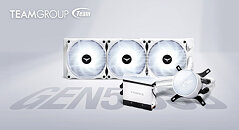Thursday, July 14th 2022

Team Group Launches AIO Cooler with Support for PCIe 5.0 NVMe SSDs
In recent years, consumer storage products have seen rapid developments. This year, the industry will officially be entering the first year of Gen5 SSDs. In response to risen temperatures caused by the high transfer speeds of PCIe Gen 5 SSDs, T-FORCE, the gaming sub-brand of Team Group, has launched the world's first all-in-one ARGB liquid cooling system to reduce heat generated by both the CPU and SSD, allowing PCIe Gen5 SSDs to maintain optimal temperatures and stable, high-speed operations for sustained periods. With the new cooling solution, consumers can fully experience the efficient storage performance of next-generation SSDs without any compromises.
Beginning in the 2000s, as the consumer market demanded higher read and write speeds for storage devices, solid-state drives (SSDs) began to replace mechanical hard drives (HDDs) in large numbers. SATA SSDs eventually became the go-to choice for storage upgrades. With the demand for high-speed storage driven by big data and the spread of transmission technology, PCIe became the standard interface for high-speed transmission. In the past few years, read speeds of PCIe SSDs have increased from 3,500 MB/s in Gen3 to 7,000 MB/s in Gen4. PCIe Gen5 SSDs now have over 12,000 MB/s read and write speeds. The large leaps in transfer speeds of each successive generation of SSDs have led to increased power wattage, which in turn have resulted in higher operating temperatures. When SSDs experience rising operating temperatures at high transfer speeds, an automatic throttling mechanism is activated to protect components from damage caused by the high temperatures. With power consumption of approximately 12 W on a PCIe Gen4 SSD running at 7,000 MB/s, the controller temperature can reach over 110℃. When PCIe Gen5 SSDs have speeds of over 12,000 MB/s and consume 14 W or above, one can expect controller temperatures to rise sharply. Therefore, Team Group is committed to providing the best thermal solutions for stable, high-speed operation of SSDs over sustained periods.In order to offer consumers the most suitable cooling solutions, Team Group has developed a variety of cooling products for different environments and utilized various cooling materials over the years. In the process, it has obtained many patents for its innovations, such as its graphene copper foil heatspreader and aluminium fin heat sink. In anticipation of next-gen PCIe Gen5 SSDs arriving this year, Team Group has launched the industry's first all-in-one ARGB liquid cooling system, solving the issue of heat generated by the CPU and SSD. To provide the best cooling products for consumers worldwide, Team Group strives to reach the next peak of performance in SSD storage solutions.
Source:
Team Group
Beginning in the 2000s, as the consumer market demanded higher read and write speeds for storage devices, solid-state drives (SSDs) began to replace mechanical hard drives (HDDs) in large numbers. SATA SSDs eventually became the go-to choice for storage upgrades. With the demand for high-speed storage driven by big data and the spread of transmission technology, PCIe became the standard interface for high-speed transmission. In the past few years, read speeds of PCIe SSDs have increased from 3,500 MB/s in Gen3 to 7,000 MB/s in Gen4. PCIe Gen5 SSDs now have over 12,000 MB/s read and write speeds. The large leaps in transfer speeds of each successive generation of SSDs have led to increased power wattage, which in turn have resulted in higher operating temperatures. When SSDs experience rising operating temperatures at high transfer speeds, an automatic throttling mechanism is activated to protect components from damage caused by the high temperatures. With power consumption of approximately 12 W on a PCIe Gen4 SSD running at 7,000 MB/s, the controller temperature can reach over 110℃. When PCIe Gen5 SSDs have speeds of over 12,000 MB/s and consume 14 W or above, one can expect controller temperatures to rise sharply. Therefore, Team Group is committed to providing the best thermal solutions for stable, high-speed operation of SSDs over sustained periods.In order to offer consumers the most suitable cooling solutions, Team Group has developed a variety of cooling products for different environments and utilized various cooling materials over the years. In the process, it has obtained many patents for its innovations, such as its graphene copper foil heatspreader and aluminium fin heat sink. In anticipation of next-gen PCIe Gen5 SSDs arriving this year, Team Group has launched the industry's first all-in-one ARGB liquid cooling system, solving the issue of heat generated by the CPU and SSD. To provide the best cooling products for consumers worldwide, Team Group strives to reach the next peak of performance in SSD storage solutions.

13 Comments on Team Group Launches AIO Cooler with Support for PCIe 5.0 NVMe SSDs
is it the speed of write and read? small pcb space and the ram are very close to each other?
i believe ssd and vram on gpu are similar, wouldnt operating at high temp on and off in the long run cause faster degredation on the ssd?
kinda insane not long ago ssd are relatively cool to touch and only require system fan to keep it cool and next thing you know it needs water cooling...
Also, this is most likely not needed, as 14 W can still be cooled passively.
Just read any of the SSD reviews here and you'll see that there's a huge variance between brands and even models from the same brand.
It could be intriguing but we all know how teamgroup likes to implement unusual cooling solutions with their SSDs and m.2s. Often only for that bright and shiny rgb blingage but occasionally they are effective. So this seems to follow suit but who knows...maybe their next drive will actually run hot enough to justify it?
How exactly do you believe that adding an SSD cooler stack to the loop would allow them to get around the seemingly impenetrable, ironclad lock they have had on block mounted pump designs since, like, forever ????